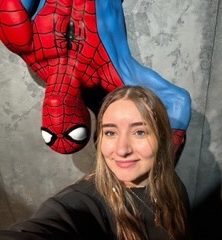By Megan Reid
My name is Megan Reid and I’m currently a first-year student at Bennington College, studying film, screenwriting and media. I’m currently interning with Art Spark Texas helping to develop and create a new Pinterest site that will host a hub of art projects guided towards all people, including kids and people with disabilities. I was excited to have the opportunity to work on this project with Art Spark Texas because while studying film and media, I think it’s always important to show and cater to all people because everyone deserves to see themselves represented. That includes in movies, on social media, the news, in books and in all the fast consumption of media we see daily.
While studying film it’s not hard to see that the film industry has come a long way in recent years, but there is still a long way to go when it comes to inclusivity and diversity on the big screen. One area where this is particularly evident is in the portrayal of people with different abilities. Despite the fact that people with disabilities make up a significant portion of the population, they have been largely ignored or misrepresented in the media. Not only because it perpetuates harmful stereotypes, but also because it denies a diverse group of people the opportunity to see themselves represented on screen. People with disabilities come from a diverse range of backgrounds and experiences, and therefore their representation in the media should also be diverse. This includes representation of different types of disabilities, different ages, races, and genders.
One of the biggest problems with the way that people with disabilities are portrayed in the media is that they are often reduced to their disability. They are defined by it, and it becomes their only characteristic. This is not only untrue, but it also reinforces the idea that people with disabilities are not fully human. The lack of representation of people with different abilities in the media not only perpetuates harmful stereotypes but also denies them the opportunity to see themselves represented on screen. This lack of representation can also lead to a lack of understanding and acceptance of people with disabilities in society. It is important that the media accurately and positively represents people with disabilities in order to change societal attitudes and promote inclusion.
Another issue is that characters with disabilities are often played by able-bodied actors, which further bolsters the idea that people with disabilities are not worthy of playing leading roles. This not only denies actors with disabilities the opportunity to break into the industry, but it also sends a message to audiences that people with disabilities are not capable of playing complex, interesting characters.
However, there have been some positive developments in recent years. For example, more and more actors with disabilities are being given the opportunity to play leading roles. This is a step in the right direction, as it helps to break down stereotypes and show that people with disabilities are fully capable of playing complex, interesting characters. Some recently have been the main cast of ‘CODA’, Starring Emilia Jones, Amy Forsyth, Daniel Durant, Marlee Matlin, and Troy Kotsur, the Oscar-winning film CODA is a movie with deaf actors playing the deaf characters of a family with a struggling fishing business. Another example is Sarah Gordy in Call the Midwife. Sarah Gordy is an actress with Down Syndrome who plays a character named Sally Harper with the same disability in Call the Midwife, which is a show about midwives from the late 1950s to the late 1960s.
Another important step is to hire more writers, directors, and producers with disabilities. When people with disabilities are in front of and behind the camera and involved in the creative process, it helps to ensure that characters and storylines are more authentic and truer to life. It makes the stories we are telling more truthful and intriguing.
While there is still a long way to go when it comes to inclusivity and diversity in the film industry and media, it is encouraging to see some positive developments in recent years. It’s important to continue to push for more authentic and diverse representation in the media, so that everyone can see themselves reflected on the big screen. The media has a powerful role in shaping societal attitudes and beliefs, and it is important that the media accurately and positively represents people with disabilities in order to promote inclusion and acceptance.

Megan is currently a freshman at Bennington College studying, film, screenwriting, philosophy, and media. She enjoys reading, writing, and spending time outdoors.
